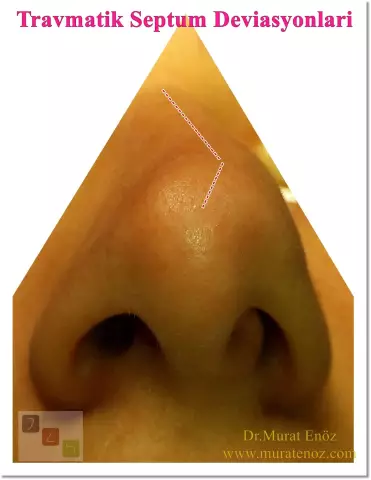- Author Rachel Wainwright [email protected].
- Public 2023-12-15 07:39.
- Last modified 2025-11-02 20:14.
Avamis
Avamis: instructions for use and reviews
- 1. Release form and composition
- 2. Pharmacological properties
- 3. Pharmacodynamics
- 4. Indications for use
- 5. Contraindications
- 6. Method of application and dosage
- 7. Side effects
- 8. Overdose
- 9. Special instructions
- 10. Application during pregnancy and lactation
- 11. Drug interactions
- 12. Analogs
- 13. Terms and conditions of storage
- 14. Terms of dispensing from pharmacies
- 15. Reviews
- 16. Price in pharmacies
Latin name: Avamys
ATX code: R01AD12
Active ingredient: Fluticasone Furoate (Fluticasone Furoate)
Producer: GlaxoSmithKline Trading (Russia)
Description and photo update: 2019-16-09
Prices in pharmacies: from 602 rubles.
Buy

Avamis is a hormonal decongestant drug for local use in diseases of the nasal cavity.
Release form and composition
The pronounced anti-inflammatory effect of Avamisu is provided by its active component - fluticasone furoate (synthetic glucocorticosteroid).
This drug is produced in the form of a nasal spray containing a homogeneous white suspension. When using a single dose, the total bioavailability (ability to be absorbed) of the drug is about 0.5%. The binding of the drug to plasma proteins is 99%. Metabolism occurs in the liver with the formation of an inactive metabolite, excreted mainly in the feces.
The spray is available in 30, 60 or 120 doses per bottle.
Pharmacological properties
Pharmacodynamics
Fluticasone furoate is a synthetic trifluorinated glucocorticosteroid with very high affinity for glucocorticosteroid receptors. It is characterized by a pronounced anti-inflammatory effect.
Pharmacokinetics
The active component of Avamis is absorbed only partially, participating in the primary metabolic processes in the liver and intestines, which causes a slight systemic effect. Intranasal administration of a dose of the drug 110 μg 1 time per day does not allow detecting the concentration of the substance in the plasma that can be measured (concentration less than 10 pg / ml). The absolute bioavailability of fluticasone furoate, administered intranasally at a dosage of 880 μg 3 times a day (the daily dose is 2640 μg), is 0.5%.
Plasma protein binding of fluticasone furoate is 99%. After reaching equilibrium concentration, the volume of distribution of the substance is approximately 608 liters.
Fluticasone furoate is excreted from the systemic circulation at a high rate (total plasma clearance is 58.7 l / h), mainly metabolized in the liver with the participation of the cytochrome P 450 isoenzyme CYP3A4 with the formation of a 17p-carboxylic metabolite (GW694301X) that does not have pharmacological activity.
In vivo studies have shown that no degradation of fluticasone furoate to fluticasone occurs.
With intravenous administration and ingestion of fluticasone, furoate and its metabolites are excreted from the body mainly through the intestines by excretion in the bile. When administered intravenously, the half-life of the drug is 15.1 hours. Approximately 2% and 1% of the substance is excreted through the kidneys when administered intravenously and orally, respectively.
The pharmacokinetics of Avamis in elderly patients was studied only in small statistical samples. In this category of patients, cases of detection of fluticasone furoate in quantifiable concentrations are observed no more often than in young patients.
In children, the plasma content of fluticasone furoate after intranasal administration of a dose of 110 μg 1 time per day is usually so small that it cannot be quantified (less than 10 pg / ml). Concentrations of the substance that can be quantified were detected in less than 16% of children in whom Avamis was administered intranasally at a dose of 110 μg once a day, and in less than 7% of children who took the drug at a dose of 55 μg once a day. There is no evidence that more quantitative concentrations of fluticasone furoate are found in children under 6 years of age.
With intranasal administration in healthy volunteers, the active component of Avamis was not detected in the urine. No more than 1% of metabolites are excreted through the kidneys, therefore, it is believed that renal dysfunction does not affect the pharmacokinetics of the drug.
Studies conducted in patients with moderate liver dysfunctions who received fluticasone furoate as a single inhalation at a dose of 400 μg showed an increase in the area under the concentration-time pharmacokinetic curve by 172% and an increase in the maximum concentration of the substance in the body by 42% compared with healthy volunteers … It is assumed that the probable exposure of the active substance Avamis at a dose of 110 μg with intranasal administration will not cause cortisol suppression and will not lead to clinically significant adverse effects. Therefore, dose adjustment in patients with mild to moderate liver dysfunctions (class A and B on the Child-Pugh scale) is not required.
There are no data for patients with severe liver dysfunctions (class C on the Child-Pugh scale). When determining the dose for this category of patients, caution should be exercised, since they are more at risk of systemic adverse reactions caused by the administration of glucocorticosteroids.
Indications for use
The drug is prescribed for the symptomatic treatment of allergic rhinitis, which manifests itself both seasonally and year-round. And also with adenoids, to reduce mucosal edema.
Contraindications
According to the instructions, Avamis is not prescribed in the following cases:
- With individual hypersensitivity to the components of the drug;
- Patients who have previously received ritonavir therapy;
- Children under two years of age.
The drug is prescribed with caution to patients with severe liver dysfunctions, as well as to pregnant women. During lactation, the drug is prescribed in the minimum effective doses.
Instructions for the use of Avamis: method and dosage
The spray is prescribed only for intranasal use (injection through the nose). The use of the drug should be carried out regularly, without missing doses.
Clinical studies indicate that a tangible effect of the drug is observed 7-8 hours after the injection of the dose. The development of the maximum therapeutic effect occurs within three days of using Avamis.
Before using the drug for the first time, shake the bottle well, remove the cap, and press the dispenser button 6 times. Such actions are necessary in order to adjust the correct dosage for further use of the spray. Dosage adjustment is also necessary if the drug has not been used within the last month.
Avamis must be injected into the previously cleaned nasal passages. Holding the bottle in an upright position, the head should be tilted slightly forward, then gently insert the tip of the bottle into the nasal passage and, while inhaling, press the dispenser button. Exhalation after using the drug is done through the mouth.
Dosage of Avamis nasal spray:
- Adults and adolescents over 12 years old - 2 injections into each nasal passage once a day, after achieving a therapeutic effect, the dose should be reduced to 1 injection in each nasal passage;
- Children from 2 to 12 years old - 1 injection into each nasal passage once a day, if necessary, for a period until the desired effect is achieved, the dose can be increased to 2 injections.
The duration of the course of treatment is determined by the doctor, based on the duration of exposure to the allergen and the patient's condition.
Side effects
Reviews about Avamis confirm the possibility of such negative consequences as:
- Ulcerative lesions of the nasal membrane;
- Nose bleed;
- Rash, pruritus, urticaria;
- Quincke's edema, anaphylactic shock;
- Developmental delay in children with prolonged use.
Overdose
In studies of the bioavailability of Avamis during intranasal administration, patients took the drug in doses 24 times higher than the recommended ones for 3 days. At the same time, no undesirable systemic reactions were noted. It is considered unlikely that an acute overdose will have to resort to measures other than medical supervision.
special instructions
It is possible to change the pharmacokinetics of fluticasone furoate in patients with significant liver dysfunction.
The use of the drug does not affect the ability to control complex mechanisms and driving vehicles.
Application during pregnancy and lactation
There are no data on the effect of Avamis on fertility. Reliable information about the features of the treatment of fluticasone furoate in pregnant women has not been provided. Animal studies have shown that the use of glucocorticosteroids can cause malformations, including intrauterine growth retardation and cleft palate. The relevance of these findings to people using the intranasal spray at therapeutic doses is questionable.
Fluticasone furoate can be prescribed during pregnancy only if the benefits of treatment for the mother significantly outweigh the likely risks to the fetus. Information on the excretion of fluticasone furoate in breast milk is insufficient, therefore, during lactation, it is used according to strict indications.
Drug interactions
Fluticasone furoate is rapidly excreted from the body, participating in the processes of primary metabolism in the liver under the action of the isoenzyme CYP3A4 of the cytochrome P 450 system. Studies conducted on volunteers who simultaneously took Avamis and a highly active inhibitor of the CYP3A4 isoenzyme - ketoconazole, showed that the concentration of fluticasone furoate in blood plasma was higher than the threshold in 6 out of 20 patients (in the case of placebo, this effect was observed in 1 out of 20 patients). This slight increase does not lead to a statistically significant change in plasma cortisol levels over 24 hours in two groups of patients: taking Avamis in combination with ketoconazole and taking placebo only.
With intranasal use of fluticasone furoate according to the instructions, there is no interaction with other drugs metabolized with the participation of isoenzymes of the cytochrome P 450 system.
The combination of Avamis nasal spray with ritonavir can lead to mutual enhancement of the action of drugs.
Analogs
There are no analogues of the drug for the active ingredient.
Analogs of Avamis in terms of the provided therapeutic effect (treatment of rhinitis, including allergic ones): Aqua Maris, Allergoferon, Allergy, Berlikort, Vibrocil, Vividrin, Galazolin, Histalong, Grippostad Rino, Dexamethasone, Diazolin, Dynos, Doxyssicicol Intal, Ketotifen, Clarisens, Claritin, Coldakt, Xylometazoline, Lordestin, Morenazal, Nazivin, Nazonex, Naphtizin, Olint, Prednisolone, Rinza, Sanorin, Suprastin, Tavegil, Farmazolin, Fervex Ervex runny nose spray, Cetirinak and drinak.
Terms and conditions of storage
The drug should be stored at temperatures between 15 and 30 ° C, avoiding direct sunlight.
Expiration date - 3 years from the date of manufacture. After the first use, the drug must be used within 2 months, after this period it is considered unusable.
Terms of dispensing from pharmacies
Dispensed by prescription.
Reviews about Avamis
Reviews of Avamis among patients are predominantly positive. They note the high effectiveness of the drug and ease of use. The nasal spray well removes the swelling of the nasal mucosa and relieves the feeling of discomfort. However, some patients are confused by the high cost of Avamis and its belonging to the group of hormonal drugs.
Although sinusitis is not a direct indication for the use of the drug, in this disease it is prescribed quite often. The nasal spray allows you to get rid of the swelling and congestion of the sinuses and improves the transport of active components of other drugs to the site of inflammation.
Experts often recommend Avamis for adenoids in children, since the spray significantly improves the condition of young patients. There have been isolated cases of ulcers on the mucous membrane and nosebleeds (usually with prolonged therapy).
Price for Avamis in pharmacies
The approximate price of Avamis in pharmacies is 576-720 rubles (for a bottle containing 120 doses).
Avamis: prices in online pharmacies
|
Drug name Price Pharmacy |
|
Avamis 27.5 mcg / dose 120 doses nasal spray dosed 1 pc. 602 RUB Buy |
|
Avamis nasal spray. 27.5mcg / dose 120 doses RUB 620 Buy |

Anna Kozlova Medical journalist About the author
Education: Rostov State Medical University, specialty "General Medicine".
Information about the drug is generalized, provided for informational purposes only and does not replace the official instructions. Self-medication is hazardous to health!






